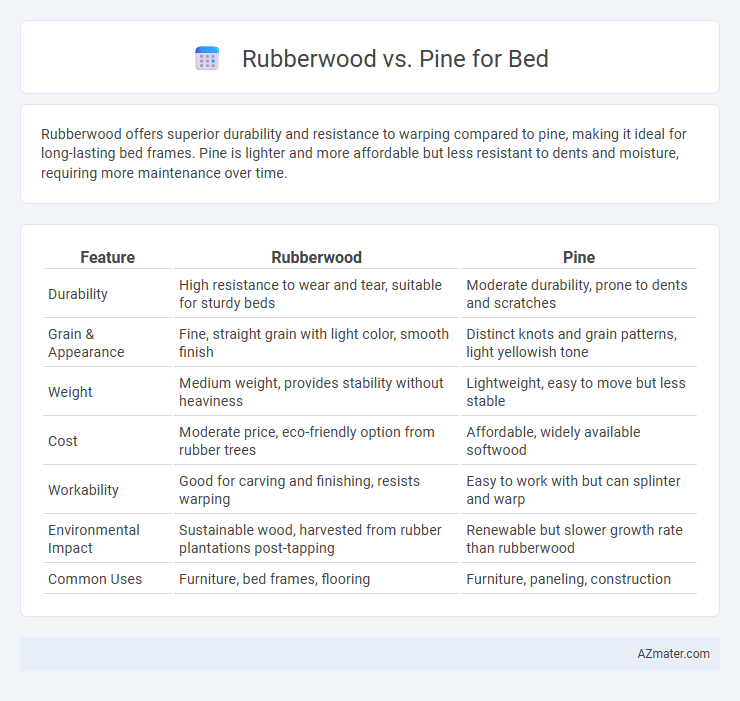Rubberwood offers superior durability and resistance to warping compared to pine, making it ideal for long-lasting bed frames. Pine is lighter and more affordable but less resistant to dents and moisture, requiring more maintenance over time.
Table of Comparison
| Feature | Rubberwood | Pine |
|---|---|---|
| Durability | High resistance to wear and tear, suitable for sturdy beds | Moderate durability, prone to dents and scratches |
| Grain & Appearance | Fine, straight grain with light color, smooth finish | Distinct knots and grain patterns, light yellowish tone |
| Weight | Medium weight, provides stability without heaviness | Lightweight, easy to move but less stable |
| Cost | Moderate price, eco-friendly option from rubber trees | Affordable, widely available softwood |
| Workability | Good for carving and finishing, resists warping | Easy to work with but can splinter and warp |
| Environmental Impact | Sustainable wood, harvested from rubber plantations post-tapping | Renewable but slower growth rate than rubberwood |
| Common Uses | Furniture, bed frames, flooring | Furniture, paneling, construction |
Overview of Rubberwood and Pine for Beds
Rubberwood is a sustainable hardwood known for its durability, resistance to warping, and smooth finish, making it ideal for sturdy, long-lasting beds. Pine is a softwood prized for its lightweight nature, affordability, and rustic charm but is more prone to dents and scratches compared to rubberwood. Both woods offer distinct aesthetic and functional benefits, with rubberwood providing strength and pine delivering cost-effective versatility.
Key Differences Between Rubberwood and Pine
Rubberwood, known for its durability and resistance to warping, offers a dense and stable option for bed frames, while pine is lighter and softer, making it more prone to dents and scratches but easier to work with. Rubberwood's natural oils provide better resistance to moisture and pests compared to pine, which requires additional treatment for longevity. Pine beds often feature a distinct grain pattern ideal for rustic or country styles, whereas rubberwood's fine, uniform grain suits modern and polished designs.
Durability and Strength Comparison
Rubberwood offers medium durability with moderate resistance to wear, making it suitable for budget-friendly beds that require stability without heavy weight. Pine is softer and less dense, leading to lower strength and increased susceptibility to dents and scratches, although it remains a popular choice for lightweight, rustic-style furniture. For long-lasting bed frames, rubberwood provides better structural integrity and resistance to warping compared to pine, ensuring a sturdier sleep foundation.
Aesthetic Appeal and Grain Patterns
Rubberwood offers a smooth, uniform grain with a light, creamy color that provides a contemporary and clean aesthetic for beds. Pine features prominent knots and a more rustic, natural appearance with warm yellowish tones that enhance cozy and traditional bedroom designs. Both woods showcase unique grain patterns that influence the overall visual appeal and style, with rubberwood leaning towards modern minimalism and pine highlighting charming, organic textures.
Environmental Sustainability
Rubberwood, sourced from plantation trees no longer producing latex, offers an eco-friendly option by utilizing timber that would otherwise be discarded, reducing deforestation impact. Pine, a fast-growing softwood, promotes sustainable forestry when harvested responsibly but may involve chemical treatments to enhance durability. Choosing rubberwood beds supports recycling of plantation byproducts, while pine beds require certification from sustainable forestry programs like FSC to ensure environmental responsibility.
Cost and Affordability
Rubberwood offers a cost-effective option for bed frames with its moderate pricing and sustainable sourcing, making it an affordable choice for budget-conscious consumers. Pine tends to be less expensive than rubberwood, often favored for its lower price point and widespread availability in the furniture market. Both materials provide affordable durability, but pine typically excels in budget-friendliness due to its natural softness and quicker growth cycle.
Maintenance and Care Requirements
Rubberwood beds demand less frequent maintenance due to their natural resistance to pests and moisture, requiring only occasional dusting and mild cleaning with a damp cloth. Pine beds need regular care to prevent dents, scratches, and warping, including polishing and ensuring the wood stays dry to avoid mold or mildew. Both materials benefit from avoiding direct sunlight exposure, but rubberwood's durability offers a lower-maintenance option for long-term bed use.
Susceptibility to Pests and Decay
Rubberwood offers better resistance to pests and decay compared to pine, thanks to its dense grain and natural latex content that deters insects and fungal growth. Pine, being a softer and more porous wood, is more vulnerable to termite attacks and moisture-related rot, requiring regular treatment to maintain durability. Choosing rubberwood for beds ensures longer lifespan and reduced maintenance in pest-prone or humid environments.
Suitability for Different Bed Designs
Rubberwood, prized for its durability and fine grain, suits traditional and modern bed designs where a smooth finish and sturdy frame are essential. Pine offers a lighter, softer wood ideal for rustic or minimalist beds, allowing easy customization and a warm, natural aesthetic. The choice between Rubberwood and Pine depends on desired bed style, longevity requirements, and ease of fabrication.
Final Verdict: Which Wood is Better for Beds?
Rubberwood offers superior durability and resistance to warping, making it an excellent choice for long-lasting bed frames, while pine is lighter and more affordable but prone to dents and scratches. The final verdict favors rubberwood for its strength, sustainability, and smooth finish, ideal for heavy use and modern aesthetics in bedroom furniture. Pine suits budget-conscious buyers or those seeking a rustic, natural look but may require more maintenance over time.

Infographic: Rubberwood vs Pine for Bed
 azmater.com
azmater.com